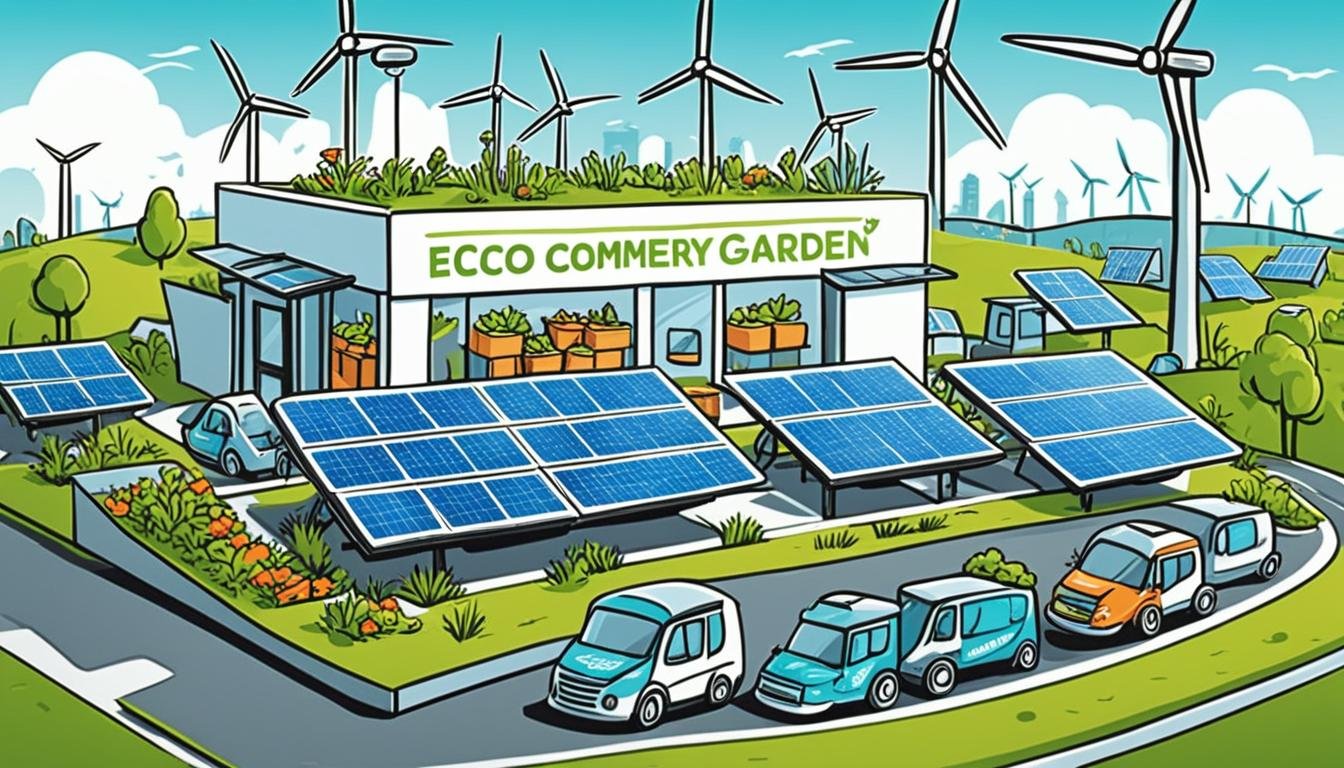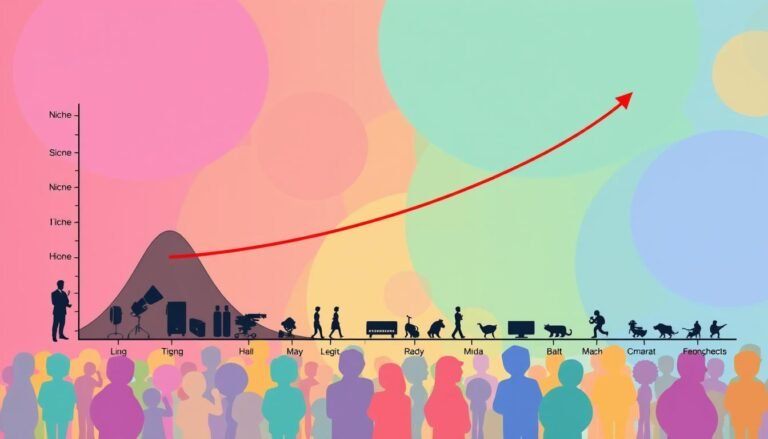Green Commerce: How Sustainable Practices are Shaping the Future of Online Sales
Have you ever thought about how your online buys affect the planet? And what steps are being taken to make things better?
Now, sustainable e-commerce is key, not just an extra choice. Big names like Patagonia and Amazon are leading the change. They’re tackling issues like packaging waste, energy use, and emissions from shipping. With online shopping expected to jump from $6 trillion to over $8 trillion by 2026, it’s clear we need to act fast. Customers want to support brands that care for the planet. By 2026, social commerce could hit $2.9 trillion, showing the big role of sustainability in online sales.
There’s a big push towards being more eco-friendly because of climate change worries. About 80% of shoppers are changing their buying habits for the planet. New ways of buying online and green business moves are making eco-friendly choices more common. This mix of new ideas and caring for the planet is changing how we sell things online, making our supply chains and logistics greener.
Key Takeaways
- Sustainable e-commerce is becoming a must due to growing awareness among consumers.
- Global retail e-commerce sales are expected to exceed $8 trillion by 2026.
- Almost 80% of shoppers are making more eco-friendly choices in their purchases.
- Brands like Patagonia and Amazon are at the forefront of green business practices.
- Concerns about the environment include waste from packaging, energy use, and emissions from shipping.
- The growth of mobile and social commerce highlights the need for sustainable e-commerce.
- Innovations in sustainability are setting the stage for the future of online sales.
The Rise of Eco-Friendly E-commerce
More businesses are going green as environmentally friendly e-commerce grows. They’re doing this to meet the growing consumer demand for green practices. This change is backed by trends and stats that show how important being green is in online shopping.
The Importance of Sustainability in E-commerce
People are now more aware of how their shopping affects the planet. A big 75% of Millennials say they’ll buy from brands that care for the earth. And 57% choose products because they know the brand is eco-friendly. This move towards greener logistics and cutting down on waste shows a big commitment to being eco-friendly.
Companies using renewable energy like solar and wind for their operations cut down on fossil fuel use. This shows how online shopping can be good for the planet and meet what customers want. Plus, better planning of deliveries can also help reduce fuel use and reduce emissions.
The Environmental Impact of Traditional E-commerce
The old way of online shopping hurts the environment a lot. Only about 14% of the plastic packaging made each year gets recycled. This shows we need to find ways to use less packaging. Also, the way online stores ship things out is a big source of greenhouse gases in the U.S., making up 29% of them.
To fight these problems, using sustainable logistics is key. By choosing green options like circular economy models and carbon-neutral shipping, online stores can meet what customers want for responsibly sourced and lower-emission products. This approach is also helping the market grow. In 2020, sales of sustainable e-commerce went up by 25.2% to $711 billion, making up 10.5% of all online shopping sales. This shows how important and successful green e-commerce is becoming.
Transforming Supply Chains with Sustainable Business Models
Companies are changing how they run their supply chains to be more sustainable. They focus on ethical sourcing and using renewable energy. This makes them better for the planet and attracts customers who care about the environment. It’s changing the industry and making companies more open about how they work.
Ethical Sourcing and Transparent Supply Chains
Now, ethical sourcing is key in the sustainable supply chain. Patagonia is a leader, working hard to be open and fair. They give 1% of their sales to protect the environment, which is over $140 million so far. This honesty helps build trust and meets what customers want from eco-friendly products.
In India, BigBasket works with local farmers to be more sustainable. This shows that being ethical and making money can go hand in hand.
The Role of Renewable Energy in Retail Operations
Using renewable energy in retail is vital for being e-commerce sustainable. Amazon wants half of its deliveries to have no net carbon by 2030. They’ve already cut down on carbon with their “Frustration-Free Packaging”.
In India, e-commerce companies are using solar power in their warehouses. This reduces energy use and harms the environment less. Moving to green warehouses shows a big change in the industry. Using renewable energy also helps brands look better and follow future laws that will be stricter.
Reducing Carbon Footprint with Green Logistics
The e-commerce world is growing fast, making it key to cut down on carbon emissions. Using green logistics helps reduce harm to the environment and makes things run better.
Innovations in Last-Mile Delivery
Last-mile delivery is changing the game in logistics. Companies like FedEx and DHL are using electric vehicles and renewable energy. These changes help cut down on emissions and win over customers who care about the planet.
Collaboration and Partnerships for Sustainable Shipping
Working together is vital for making shipping greener. Amazon’s “Shipment Zero” plan wants 50% of all shipments to be carbon-neutral by 2030. These partnerships help the environment and encourage more companies to go green.
Optimizing Delivery Routes for Reduced Emissions
Improving delivery routes is a big step towards lowering emissions. UPS uses smart algorithms to find the best delivery paths. This cuts fuel use and reduces carbon emissions. It also makes deliveries faster and happier customers.
Exploring Green Commerce in Depth
In today’s world, green commerce is key to the future of online sales. It looks at how e-commerce is now a big part of the digital green revolution. This includes using eco-friendly labels to help customers make better choices.
Platforms like Etsy are leading the way in creating an eco-friendly marketplace. They encourage sellers to share their sustainable practices. This makes it easy for customers to support brands that care about the planet.
These platforms focus on ethical sourcing and clear supply chains. This matches what customers want when they buy green products.
Companies are also using renewable energy and being more efficient in their operations. For example, using solar power and electric delivery trucks cuts down on carbon emissions. This shows a strong commitment to being sustainable.
Managing natural resources well is crucial, as shown by global goals and what consumers do. In rich countries, people use much more resources than in poor ones. So, making online sales more sustainable is vital.
This means reducing waste and using resources wisely. It’s up to e-commerce giants like Amazon to lead the way with new ideas. Initiatives like “Frustration-Free Packaging” and “Shipment Zero” show how we can make a big difference. These efforts help meet the needs of customers who care about the planet.
Sustainable Packaging Solutions in the E-commerce Sector
In the fast-changing e-commerce world, sustainable packaging is becoming more popular. Companies are now focusing on reducing their environmental impact. This shift meets the needs of eco-aware customers and helps follow new laws to cut down on waste.
Biodegradable and Recyclable Packaging Materials
Companies are using biodegradable and recyclable materials to cut down on waste. For example, bioplastics made from plants are a green choice instead of regular plastics. Corrugated packaging, with 70% to 100% recycled content, is another eco-friendly option that helps the planet.
Innovative Packaging Design for Minimal Waste
Designing new packaging that reduces waste is key. Brands like Glossier use smart designs, like pink bubble wrap pouches instead of boxes, to use less material. This approach cuts down on waste and uses fewer resources, helping the environment.
Reusable Packaging Systems
Reusable packaging is also vital for sustainability. Programs like RePack let customers return packaging to get discounts, promoting reuse. By using these systems, e-commerce companies show they care about the planet and connect better with customers who do too.
Promoting Conscious Consumerism through Education and Transparency
Making consumers more aware is key to a greener online shopping world. This movement is built on environmental transparency and strong learning efforts. Retailers use different ways to help shoppers pick greener options.
Sustainable e-commerce education is at the heart of this change. Through blogs, product stories, and videos, companies show the good in living sustainably. Patagonia is a leader with their ‘Worn Wear’ campaign, encouraging the buying and fixing of old items. This approach educates customers who care about the planet.
Brands like Everlane have done well by being open and true. They show how they work to be green, building trust with shoppers who care about the earth. This openness can be boosted with eco-labels, certifications, and detailed reports on being green.
Transparency and vulnerability in brand communication are key to building trust and authenticity.
Using green marketing strategies like social media and interactive content helps too. These methods teach and get people involved, pushing them to live more sustainably. With 73% of shoppers ready to change for the planet, the push for better choices is clear.
Tools like AI-powered advice and carbon calculators also teach shoppers about their buying’s effect on the planet. They suggest greener options based on what you buy and like, helping shoppers understand and support sustainable shopping.
By teaching and being open with their customers, online stores can create a culture of mindful shopping. This approach boosts sales and supports taking care of the earth.
The Impact of Circular Economy Models on Online Sales
The circular economy is changing how we sell things online. Instead of just taking, making, and throwing away, companies now focus on using products again, recycling, and making things last longer. This change helps the economy grow without using more resources and cuts down on harm to the environment.
Implementing Reuse and Recycling Practices
Now, e-commerce sites are all about reusing and recycling to be more sustainable. Brands like H&M and Eileen Fisher ask customers to bring back old clothes for recycling. This helps products last longer and teaches people to consume in a green way. Using materials that can be reused and eco-friendly packaging also helps lower the carbon footprint of online sales.
Encouraging Product Refurbishment and Longevity
More e-commerce companies are pushing for products to last longer through repair and refurbishment. Patagonia is a leader, offering repair services and making products from recycled materials. This supports the circular economy and makes customers more loyal by adding value to their purchases. Sites for buying second-hand items and renting seasonal clothes or special tools also help make online sales more sustainable.
Case Studies: Successful Sustainable E-commerce Businesses
Looking at sustainable e-commerce shows how big brands are making a change. We’ll talk about Patagonia, Amazon, and Etsy. They’re leading the way with their green efforts. These companies show us how being eco-friendly can help businesses grow.
Patagonia’s Environmental Initiatives
Patagonia is a top name in sustainable e-commerce. They use recycled materials and organic cotton. They also support environmental causes and advocate for change. This makes them a role model for others.
Since 2014, sustainable products have grown by 20%, says the Environmental Defense Fund. Patagonia’s success shows that caring for the planet can attract customers and lead to growth.
Amazon’s “Frustration-Free Packaging” and “Shipment Zero”
Amazon is working hard to reduce waste and emissions. Their “Frustration-Free Packaging” and “Shipment Zero” programs help a lot. This packaging uses less plastic and makes shipping better for the planet.
Amazon wants to make half of all shipments carbon neutral by 2030. This effort not only saves money but also makes customers more loyal. People want to buy from companies that care about the planet.
Etsy’s Focus on Eco-friendly Products
Etsy focuses on eco-friendly products. It helps small businesses and artists go green. By being open about their green efforts, Etsy builds a community of buyers who care about the planet.
Companies that focus on sustainability look better and gain more loyal customers. Etsy is a great example of how being green can lead to success and a strong customer base.
These examples show how businesses can be more eco-friendly. They save money, gain loyal customers, and find new opportunities. This movement is making e-commerce more sustainable for everyone.
Conclusion
The future of green commerce is clear: it’s essential, not just a trend. E-commerce sales are set to double by 2028, now making up 19.1% of all retail sales. This growth brings big challenges and chances to make profits and protect the environment.
We’ve looked at how sustainable e-commerce works. It includes ethical sourcing, clear supply chains, and green logistics. Companies like Patagonia, Amazon, and Etsy show how being green can attract customers and save money. They’re cutting down on carbon and waste, showing the way for others.
More people now choose brands that care for the planet. This change is good news for e-commerce’s future, where shopping can be both easy and eco-friendly. Using the circular economy and tech like AI can cut down on pollution and use resources better. As e-commerce grows, going green is key to staying ahead and doing right.
Source Links
- E-commerce trends 2024: 15 eye-popping insights for the future of online shopping
- Sustainable Ecommerce: Impact + Importance of Becoming Eco-Friendly
- 14 Ecommerce Trends That Will Be The New Norm – EcoCart
- Embracing Sustainable Practices in eCommerce: Paving the Way for a Greener Future
- Eco Friendly E-commerce: Driving Demand through Sustainable Practices
- Sustainable E-commerce Practices: Navigating a Green Future
- Why Sustainable E-Commerce Will Drive The Future? – Juphy
- Sustainable E-Commerce: Delivering a Greener Tomorrow
- Sustainable E-commerce: How Retailers Are Going Green
- Assessing the E-Commerce Sustainability Readiness: A Green Logistics Study on Online Sellers
- Analysing the Influence of Green Marketing Communication in Consumers’ Green Purchase Behaviour
- Sustainable consumption and production
- Sustainability
- The Significance of Eco-Friendly Packaging in eCommerce
- 2024 Sustainable eCommerce Growth: Key Trends Shaping Shopping
- How the Challenges with Transparency & Sustainability Will Shape eCommerce’s Future
- Sustainable eCommerce: Navigating Green Trends | Solveda
- eCommerce and the Circular Economy: A Match Made in Sustainable Heaven
- 10 Sustainable E-commerce Trends | Green City Times
- Adopting sustainable ecommerce practices at scale | HCLTech
- Ecommerce Sustainability: A Practical Guide to Driving Change
- The Power of Sustainable E-Commerce: Driving Profitability Through Eco-Friendly Practices
- How Does Online Shopping Affect the Environment?
- Sustainable Web Design in 2023: How Eco-Friendly Practices are Shaping the Digital Landscape | Brainstorm Design
- Sustainable and resilient e-commerce under COVID-19 pandemic: a hybrid grey decision-making approach







